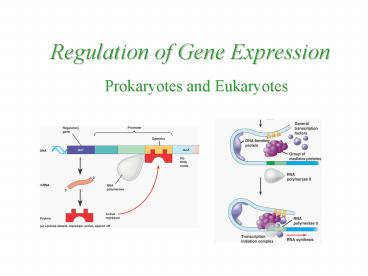Regulation of Gene Expression PowerPoint PPT Presentation
1 / 28
Title: Regulation of Gene Expression
1
Regulation of Gene Expression
- Prokaryotes and Eukaryotes
2
Regulation of Gene Expression
- A cell contains the entire genome of an organism
ALL the DNA. - Gene expression transcribing and translating
the gene - Regulation allows an organism to selectively
transcribe (and then translate) only the genes it
needs to. - Genes expressed depend on
- the type of cell
- the particular needs of the cell at that time.
3
Gene Regulation in Prokaryotes
- Prokaryotes organize their genome into operons
- Operon a group of related genes
- One promoter sequence at the very beginning
- All of the genes will be transcribed together (in
one long strand of RNA.
4
Question
- What is the benefit of organizing the genome into
operons? - Its more efficient transcribe everything you
need for a process at once.
5
Repressible Operon Trp Operon
- Repressible Operon Operon that is usually ON
but can be inhibited - The Trp Operon
- example of a repressible operon
- Genes that code for enzymes needed to make the
amino acid tryptophan
6
TrpR Gene
- TrpR gene is the regulatory gene for the Trp
operon - Found somewhere else on the genome
- NOT part of the Trp operon
- TrpR gene codes for a protein TrpR repressor
- TrpR gene is transcribed and translated
separately from the Trp operon genes.
7
TrpR Repressor
- Repressor protein is translated in an inactive
form - Tryptophan is called a corepressor
- When tryptophan binds to the TrpR repressor, it
changes it into the active form
8
Operator Region
- There is also an operator region of DNA in the
Trp Operon - Just after the promoter region
- The TrpR Repressor can bind to the operator if
its in the active form
9
Trp Operon
- Transcription is ON
- Occurs when there is no tryptophan available to
the cell. - Repressor is in inactive form (due to the absence
of tryptophan) - RNA Polymerase is able to bind to promoter and
transcribe the genes.
10
Trp Operon
- Transcription is OFF
- Occurs when tryptophan is available
- Tryptophan binds to the TrpR repressor ? converts
it to active form - TrpR protein binds to operator ? blocks RNA
Polymerase ? no transcription
11
Question
- Under what conditions would you expect the trp
operon to go from OFF to ON again? - When there is no longer tryptophan available all
of it has been used up
12
Inducible Operon Lac Operon
- Inducible operon operon is usually OFF but
can be stimulated/activated - Lac Operon
- Example of an inducible operon
- Genes code for enzymes that break down lactose
13
LacI gene
- LacI gene is the regulatory gene for the lac
operon - Found somewhere else on the genome
- NOT part of the lac operon
- LacI gene codes for a protein lacI repressor
- LacI gene is transcribed and translated
separately from the lac operon genes.
14
LacI Repressor
- The lacI repressor protein is translated into an
active form - When the lacI repressor is bound by lactose (also
called allolactose) it becomes inactive - Lactose is the inducer
15
Lac Operon
- Transcription is OFF
- When there is no lactose that needs to be
digested - lacI repressor is in active form ? binds to
operator ? blocks RNA Polymerase ? no
transcription
16
Lac Operon
- Transcription is ON
- When there is lactose that needs to be digested
- Lactose binds to lacI repressor ? inactivates it
- RNA Polymerase is able to bind to promoter ?
transcribe genes
17
Do all operons have operator regions?
- NO
- There are some genes that always need to be
transcribed ? they do not need to have operators
to regulate them in this manner. - Ex. genes that participate in cellular respiration
18
Positive Gene Regulation
- In the lac operon there are other molecules to
further stimulate transcription. - Lactose will only be digested for energy when
there isnt much glucose around - When glucose levels are low, level of cAMP
molecule builds up
19
cAMP and CAP
- CAP regulatory protein that binds to cAMP
- CAP is inactive unless cAMP binds to it
20
Positive gene regulation
- If there isnt much glucose? high levels of cAMP
- CAP and cAMP bind ? CAP can bind to the promoter
? stimulates RNA Polymerase to bind
21
Positive gene regulation
- When glucose levels rise again, cAMP levels will
drop ? no longer bound to CAP - CAP cant bind to promoter ? transcription slows
down
22
Positive gene regulation
- The lac operon is controlled on 2 levels
- Presence of lactose determines if transcription
can occur - CAP in the active form determines how fast
transcription occurs
23
Gene Regulation in Eukaryotes
- Eukaryotes have large genomes
- Other molecules have to help RNA Polymerase find
the promoter and start transcription - Transcription factors
- Enhancer sequences
24
Transcription Factors
- Series of proteins that bind to the promoter to
help RNA Polymerase bind - RNA Polymerase also has to bind transcription
factors in order to be able to start
transcription.
25
Question
- How might binding transcription factors help RNA
Polymerase bind? - Creates an area that chemically attracts RNA
Polymerase more
26
Enhancer sequences
- Sequences of DNA that are far away from the gene
they help transcribe - Process
- Activator molecules bind to the Enhancer sequence
- Enhancer loops around so that the activators can
also bind to the transcription factors - Together with RNA polymerase they all cause
transcription to start
27
Cell-specific Regulation
- Each cell has the DNA to transcribe any gene
- Different activators and transcription factors in
specific cells will determine which genes are
transcribed ? which proteins are translated
28
(No Transcript)

